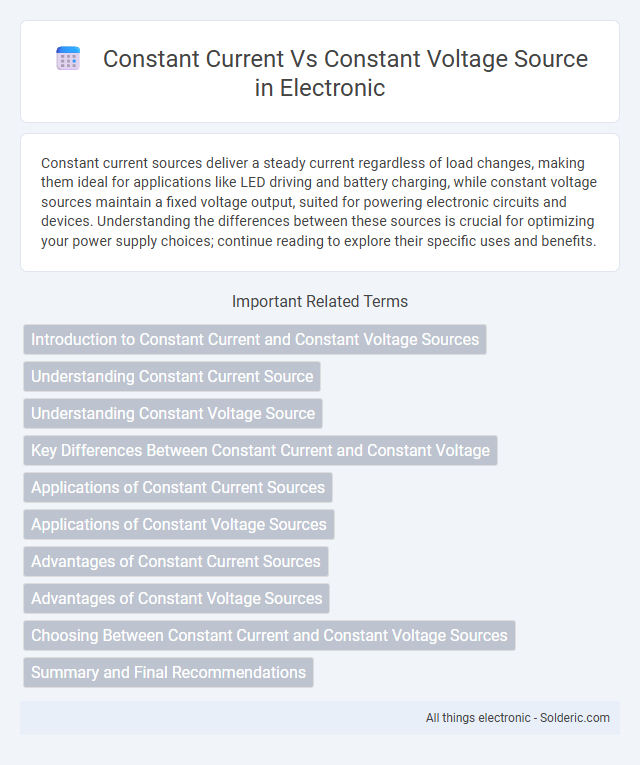Constant current sources deliver a steady current regardless of load changes, making them ideal for applications like LED driving and battery charging, while constant voltage sources maintain a fixed voltage output, suited for powering electronic circuits and devices. Understanding the differences between these sources is crucial for optimizing your power supply choices; continue reading to explore their specific uses and benefits.
Comparison Table
| Feature | Constant Current Source | Constant Voltage Source |
|---|---|---|
| Output Regulation | Maintains fixed current regardless of load variations | Maintains fixed voltage regardless of load variations |
| Applications | LED driving, battery charging, welding machines | Power supplies, household electronics, lighting systems |
| Load Behavior | Voltage varies with load changes | Current varies with load changes |
| Protection | Prevents overcurrent damage to sensitive devices | Prevents overvoltage damage to devices |
| Typical Sources | Current regulators, programmable current sources | Transformers, DC power supplies, batteries |
| Control Method | Adjusts voltage to keep current constant | Adjusts current to keep voltage constant |
Introduction to Constant Current and Constant Voltage Sources
Constant current and constant voltage sources are essential in electrical circuits, providing stable power under varying conditions. A constant current source delivers a fixed current regardless of load resistance, ideal for applications like LED driving and battery charging. Conversely, a constant voltage source maintains a steady voltage output, commonly used in power supplies and electronic devices requiring consistent voltage levels.
Understanding Constant Current Source
A constant current source delivers a steady current regardless of voltage changes or load variations, ensuring reliable operation in applications like LED lighting and battery charging. It adjusts its output voltage dynamically to maintain a fixed current, protecting sensitive electronic components from current fluctuations. This characteristic makes constant current sources essential for circuits requiring precise current regulation and stability.
Understanding Constant Voltage Source
A constant voltage source delivers a fixed voltage regardless of the load current, ensuring stable voltage output for devices requiring precise voltage levels. It is commonly used in applications like power supplies, battery chargers, and LED drivers, where voltage consistency is critical to performance. The source adapts its current output to maintain the specified voltage, preventing voltage drops or spikes that could damage sensitive components.
Key Differences Between Constant Current and Constant Voltage
Constant current sources maintain a steady current flow regardless of voltage fluctuations, making them ideal for LED driving and battery charging applications. Constant voltage sources provide a fixed voltage output while allowing current to vary, commonly used in power supplies for electronics and appliances. The key difference lies in their regulation focus: constant current sources prioritize current stability, whereas constant voltage sources prioritize voltage stability.
Applications of Constant Current Sources
Constant current sources are essential in applications like LED driving, battery charging, and electroplating, where maintaining a steady current is critical for performance and safety. These sources prevent overcurrent damage by regulating the current regardless of load variations, ensuring reliable operation in sensitive electronic circuits and medical devices. Your choice of a constant current source optimizes efficiency and protection in precision equipment requiring stable current flow.
Applications of Constant Voltage Sources
Constant voltage sources are essential in powering devices that require a stable voltage regardless of load variations, such as LED lighting, battery charging, and electronics testing. These sources maintain a fixed voltage output, ensuring sensitive components operate safely and efficiently without damage from voltage fluctuations. Your electronic projects benefit from consistent performance and protection when utilizing constant voltage supplies.
Advantages of Constant Current Sources
Constant current sources maintain a steady current regardless of voltage fluctuations, making them ideal for applications such as LED lighting and battery charging where consistent current is crucial for performance and longevity. They prevent damage caused by current surges, enhancing the reliability and safety of electronic circuits. Constant current sources also improve energy efficiency by delivering precise current tailored to load requirements, reducing power waste.
Advantages of Constant Voltage Sources
Constant voltage sources provide stable output voltage regardless of load variations, ensuring consistent performance in devices like LEDs and power supplies. They minimize power loss and improve energy efficiency by maintaining voltage within specified limits. Your electronic components benefit from enhanced safety and longevity due to reduced voltage fluctuations.
Choosing Between Constant Current and Constant Voltage Sources
Choosing between a constant current and constant voltage source depends on your application's requirements for power delivery and device protection. Constant current sources maintain a steady current, ideal for LED drivers and battery charging, while constant voltage sources provide a fixed voltage, suitable for powering electronic circuits and sensors. Understanding your load characteristics ensures you select the appropriate source to optimize performance and prevent damage.
Summary and Final Recommendations
Constant current sources provide a steady current regardless of load variations, making them ideal for LED driving and battery charging applications, while constant voltage sources maintain a fixed voltage output suited for powering electronic circuits and devices. Selecting between the two depends on the specific application requirements, load characteristics, and desired control precision. For reliable power delivery in sensitive electronics, use constant voltage sources; for applications demanding stable current flow, constant current sources are recommended.
Constant Current vs Constant Voltage Source Infographic

 solderic.com
solderic.com